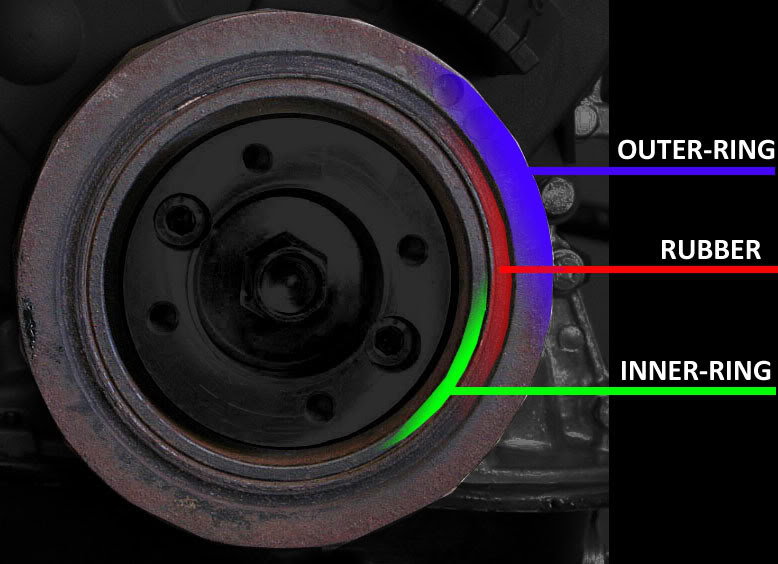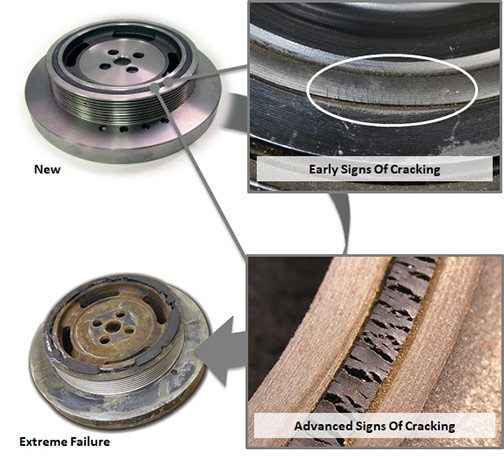As an Amazon Associate, I earn from qualifying purchases at no extra cost to you.
What are the Symptoms of a Bad Harmonic Balancer?
Symptoms of a bad harmonic balancer include engine vibrations and noise. You may also experience misalignment issues.
The harmonic balancer plays a crucial role in the smooth running of your engine. When it begins to fail, you may notice these warning signs, indicating a potential problem that needs attention. Understanding the symptoms of a bad harmonic balancer can help you address the issue promptly, preventing further damage to your vehicle.
By recognizing these signs early on, you can avoid more costly repairs down the line and ensure the continued performance of your engine. Let’s delve deeper into the common symptoms associated with a failing harmonic balancer.

Credit: www.clublexus.com
Common Symptoms Of A Bad Harmonic Balancer
Excessive Vibrations
Excessive vibrations in the engine can be a key indicator of a faulty harmonic balancer. Vibrations may be felt throughout the vehicle, particularly when idling or accelerating. These vibrations can impact the overall driving experience and should be addressed promptly.
Engine Misalignment
A telltale sign of a bad harmonic balancer is engine misalignment. This can manifest as the engine appearing off-center or visibly shaking while running. Misalignment can cause further damage to the engine if left unattended, impacting the overall performance of the vehicle.
Engine Noise
When the harmonic balancer begins to wear down, unusual engine noises may become noticeable. These can include knocking or rattling sounds coming from the engine bay. Addressing these noises promptly can prevent more extensive engine damage.
Damaged Belts Or Pulleys
A bad harmonic balancer can lead to damage to belts and pulleys, as the imbalance puts additional strain on these components. Inspecting the belts and pulleys for wear, fraying, or misalignment can help identify issues related to the harmonic balancer.

Credit: fluidampr.com
Causes Of A Bad Harmonic Balancer
A bad harmonic balancer can lead to various symptoms that indicate potential issues with your vehicle’s engine. Understanding the causes of a bad harmonic balancer can help you identify and address the problem promptly.
Worn-out Rubber Material
The rubber material in the harmonic balancer becomes worn out with time, causing imbalance.
Incorrect Installation
Incorrect installation of the harmonic balancer can result in misalignment, leading to malfunction.
Engine Damage
Excessive wear on the harmonic balancer can lead to engine damage and further issues.
Diagnosing A Bad Harmonic Balancer
Visual Inspection
Check for any signs of wear, like cracks or separation in the rubber dampener.
Belt And Pulley Examination
Examine the drive belt and pulley alignment for any unusual vibrations while running.
Using A Harmonic Balancer Puller
Utilize a harmonic balancer puller to remove the balancer for closer inspection.

Credit: medium.com
Repair And Replacement Options
When it comes to a bad harmonic balancer, it’s important to understand the symptoms and know the repair and replacement options available. Addressing these issues promptly can prevent further damage to your vehicle and keep it running smoothly. Here’s what you need to know about repairing a damaged harmonic balancer and replacing a bad one.
Repairing A Damaged Harmonic Balancer
If you suspect that your harmonic balancer is damaged, it’s essential to address the issue promptly. The following steps can help in repairing a damaged harmonic balancer:
- Inspect the harmonic balancer for visible signs of damage, such as cracks, separation, or misalignment.
- If minor damage is detected, consider having a professional mechanic repair the harmonic balancer using specialized tools and techniques.
- Ensure that the repair process is carried out meticulously to restore the balancer’s functionality and prevent further issues.
Replacing A Bad Harmonic Balancer
If your harmonic balancer is beyond repair, it’s crucial to opt for a replacement to ensure your vehicle’s optimal performance. Here’s what you should consider when replacing a bad harmonic balancer:
- Purchase a high-quality replacement harmonic balancer that is compatible with your vehicle’s make and model.
- Consult a professional mechanic to ensure the proper installation of the new harmonic balancer to prevent any future problems.
- Follow the manufacturer’s recommendations for maintenance and periodic inspections to prolong the lifespan of the new harmonic balancer.
Preventive Measures For Harmonic Balancer Issues
Harmonic balancer issues can be prevented by recognizing the symptoms of a bad balancer, such as engine vibration, unusual noises, and engine misfire. Regular inspection and maintenance can help avoid costly repairs and ensure the smooth functioning of the balancer.
A harmonic balancer plays a crucial role in the smooth operation of your vehicle’s engine. However, like any automotive component, it can develop problems over time. Being aware of the symptoms of a bad harmonic balancer is essential, but taking preventive measures can save you from costly repairs or potential engine damage. In this section, we will discuss two key preventive measures that drivers can take to minimize the risk of harmonic balancer issues. These measures include regular maintenance and inspections, as well as proper installation techniques.
Regular Maintenance And Inspections
Regular maintenance and inspections are crucial to ensure the proper functioning of the harmonic balancer and detect any potential issues before they escalate. By adhering to a regular maintenance schedule and conducting thorough inspections, you can identify early signs of damage or wear and take necessary actions to prevent further problems.
Here are some important maintenance tips to keep your harmonic balancer in good condition:
- Inspect the harmonic balancer during routine oil changes.
- Look for signs of wear, such as cracks, loose bolts, or separation between the hub and outer ring.
- Listen for any abnormal noises, vibrations, or squeaking sounds, which may indicate an underlying problem with the harmonic balancer.
- Check for fluid leaks near the harmonic balancer, as leaks can cause damage to the rubber components.
- Ensure the harmonic balancer is properly aligned and centered.
- Tighten any loose bolts or mounting hardware.
By following these simple maintenance practices, you can catch potential issues early and address them promptly, thus preventing further damage to your harmonic balancer and engine.
Proper Installation Techniques
Another crucial preventive measure to ensure harmonic balancer longevity is proper installation techniques. When installing a harmonic balancer or replacing a worn-out one, it is important to follow the manufacturer’s guidelines and recommendations to avoid problems in the future.
Here are some key points to consider when installing a harmonic balancer:
- Clean the crankshaft snout thoroughly before installation.
- Apply a thin layer of lubricant to the crankshaft snout to ease the installation process.
- Ensure the harmonic balancer slides smoothly onto the crankshaft without any forceful tapping or hammering.
- Torque the harmonic balancer bolts to the manufacturer’s specifications using a torque wrench.
- Double-check the alignment of the balancer with the engine components.
By following these proper installation techniques, you can avoid potential damage to the harmonic balancer and ensure its smooth operation.
Conclusion
Being aware of the symptoms of a bad harmonic balancer can save you time and money in the long run. By detecting issues early on, you can prevent more extensive damage to your vehicle’s engine and other components. If you notice any signs of a failing harmonic balancer, it’s crucial to address them promptly.
Keep your vehicle running smoothly by staying informed and proactive.


